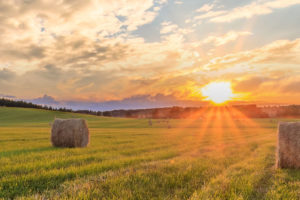The title of this article is an oversimplification of the decision process for the type of land loan you should get…but you’ve read this far, so at least it got your attention. When I say your loan should be “long-term”, I mean the interest rate should be fixed for multiple years (usually 10+). There are some situations where you wouldn’t necessarily need a long-term fixed rate ― for instance, if you’re not planning to own the land for many years, or you’re planning to come into a big pile of money and pay off your loan early (wouldn’t that be nice!). But, my usual recommendation to clients is to match their interest rate with the time horizon of your investment. So, if you intend to keep your new land purchase in the family for years to come, it just makes sense to consider a long-term fixed rate loan. Here’s why.
Whether you like it or not, when you decide how long you want to fix the interest rate of a loan, you are speculating on interest rates. If you plan to own a tract of land for 30+ years, but you only fix your interest rate for three years, you are taking a risk that rates will be significantly higher in three years…potentially so high that you couldn’t afford your land purchase anymore.
However, you are also taking a “position” on interest rates if you lock in your rate for the full term of the loan, because rates may fall and you would be paying an above-market interest rate. But, this scenario is much better than the first since you can refinance to the now lower rates. Some cost will likely be involved to do this, but you would only refinance if the new rate were low enough to offset any fees you had to pay. (Personally, I would rather pay some fees to get my rate lowered than lose sleep at night wondering whether interest rates are going to skyrocket and hit me in the wallet.)
Long story short, if you’re planning to hold on to your land purchase for the long-term, I recommend you lock in your interest rate for the long term as well. Shameless marketing plug in 3, 2, 1….one of the few lenders that offers long-term rates on land is Farm Credit.
In case you’re not convinced yet, let’s look at where interest rates are today compared to historical levels. The chart below shows data on some widely followed interest rates.
|
Current Rate |
Historical Average |
|
| Prime Rate |
3.25% |
9.84% |
| 2-year Treasury |
0.20% |
6.21% |
| 10-year Treasury |
2.04% |
7.08% |
Unless you’ve been living under a rock the last few years, you know interest rates are currently very low. But, the chart above puts this in perspective when you see that Prime is more than 6% lower than the average over the last 34 years. How would like the interest rate on your land loan to jump 6% higher? Or worse yet, consider what your rate would be if Prime hit 21.5% like it did in 1980, and your short-term fixed rate expired and the bank reset to current market rates. Like my fourth-grade teacher Mrs. Davis used to tell us: “A word to the wise is sufficient.” I can’t tell you when rates will go up, but I can tell you it will happen, so please consult with your lender or trusted advisor to make sure you choose the interest rate product that is right for you.
This content may not be used or reproduced in any manner whatsoever, in part or in whole, without written permission of LANDTHINK. Use of this content without permission is a violation of federal copyright law. The articles, posts, comments, opinions and information provided by LANDTHINK are for informational and research purposes only and DOES NOT substitute or coincide with the advice of an attorney, accountant, real estate broker or any other licensed real estate professional. LANDTHINK strongly advises visitors and readers to seek their own professional guidance and advice related to buying, investing in or selling real estate.










Add Comment